






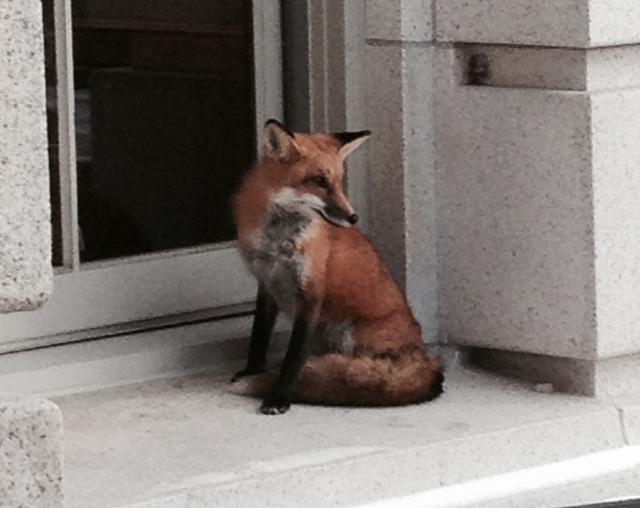
Near the railroad track lining Warner Park, depressions in the snow marked many paths – coming, going and crossing. Some of the prints set close together, others further apart.
Most of the tracks belonged to two foxes, according to Madison resident Rhonda Martin.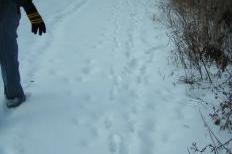
Martin lives near Warner Park on Madison’s north side, and sees the foxes so regularly she can keep track of their family trees. She can list the members of the family individually, noting when and how many babies (known as kits) each had, as if she knew them personally.
One female fox had two kits in 2011, one of which took over territory near the baseball field where the Madison Mallards play. He’s still there, Martin said. The other kit – a female – made a den down the railroad tracks from her mother, and had five kits of her own in 2013. She and four of her kits were run out of the territory by the fifth, a male.
“He’s the only one that’s in that den now. But he still can’t kick grandma’s ass. She’s still over there,” Martin said, laughing. Locate the Warner Park foxes here.
Martin tells them apart by their distinct appearance: the original and still present female is tall, slender and has light, “strawb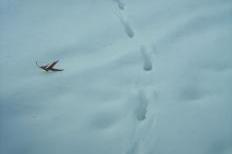
Martin can also tell them apart by the tracks they leave in the snow: the male’s are closer together, as his legs are shorter, while the female takes longer strides.
Urban foxes like these have been making appearances all over Madison in recent years, including the pair seen lounging around Capitol Square the first week of January.
Trish O’Kane, a PhD candidate in environment and resources at the Nelson Institute of UW-Madison, has noticed an increase in fox visibility in Warner Park since park management stopped mowing the fields every week, instead mowing once a year. She spotted them during the 500 hours of observation she logged for a biodiversity survey of the park.
Before the mowing change, she saw them once in a summer; after, it became once a week. Neighbors in the area came to her with reports of more sightings – a “huge increase” – after the change, O’Kane said.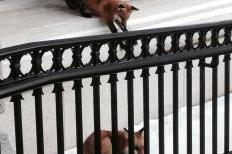
“They’re much more visible and prominent, so I believe there are more of them but I cannot scientifically document that,” O’Kane said, expressing the desire for an urban wildlife study to be done in Madison.
The Wisconsin DNR does not track fox populations, but DNR wildlife biologist Andy Paulios suggested in a piece for Northside News that this year’s high rabbit population may have resulted in a higher fox population.
Without tracking them, it’s hard to say if the foxes have increased in number or if something else is causing the sighting increase, said fox expert Tim Susman. He studied fox ecology in urban areas while earning his master’s degree in zoology from the University of Minnesota.
One of the reasons foxes might opt for city living is the abundance of food, according to Susman. They can adapt to almost any living situation as long as they can find food, which they can get “just about anywhere,” he said.
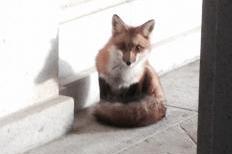
The abundance of food per square mile means that more foxes can live in a smaller area than they could in wild habitats.
“They’re territorial to some extent but they can shrink those territories, and as long as they’re getting enough food, they can be OK with it,” Susman said.
Certain benefits accompany the presence of the urban fox. Fewer rodents, for example. Fewer geese as well, according to O’Kane, as geese can become problematic in high numbers.
But O’Kane has a unique perspective when it comes to the benefits.
“From my point of view as an educator, the fox is a tax-free educational assistant,” she said. O’Kane teaches environmental studies in the Nelson Institute, including a mentoring program between UW-Madison undergraduates and students from Sherman Middle School. She takes the students to Warner Park every week.
“If the fox shows up in Warner Park while I have 50 young people in there, it’s a lesson plan on steroids,” she said. “The fox is the ideal helper for environmental educators and outdoor educators.”
Other Madison residents like to watch the animals too. The family of five kits described by Martin drew attention from drivers last summer.
“All summer around cocktail hour, people were pulling up near that den because it was very close to the road,” O’Kane said. “People lined up like it’s, you know, happy hour. ‘Let’s go have happy hour with the foxes.’”
The problem, according to Martin, is when foxes lose their healthy fear of humans. “They got familiar with us enough to where I’d be out raking the lawn and one would pass within 20 feet of me, just walking by. Just look at me and just walk on by,” she said.
Both O’Kane and Susman echoed the sentiment.
“There’s a temptation to either go out and feed them or go out and hunt them, and…my view on them is appreciate them from a distance,” Susman said. “They’re beautiful animals to watch, but they’re wild animals and if you leave them alone, they’ll do their thing, they’ll keep down the mice and the rats and they won’t bother people in general.”
Feeding urban foxes can cause them to approach other people, including those who are afraid of wild animals, Susman said. Foxes can also become dependent on humans who feed them, which can be problematic if the food supplier leaves for an extended period.
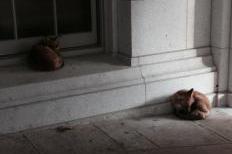
Watching a fox can be a powerful experience, especially for the middle school students from O’Kane’s mentoring program.
“I saw a kid sit down in the meadow and write a poem after he saw a fox,” she said. “I can’t quantify what that means to these kids, but it’s magical. They’re reaction is just totally magical. They all want to see the fox.”
If you’re still wondering what the fox says, we encourage you to check out this video of fox calls or this one of its scream.
|
|
|
Welcome to the Madison Commons, a website designed to provide news and information about all of Madison's neighborhoods and a crossroads for the discussion of community issues. The name comes from the idea of a village commons, a place for news, talk, debate, and some entertainment, too, that's open to everyone.
All rights reserved. Read more about the Madison Commons and its partners.

